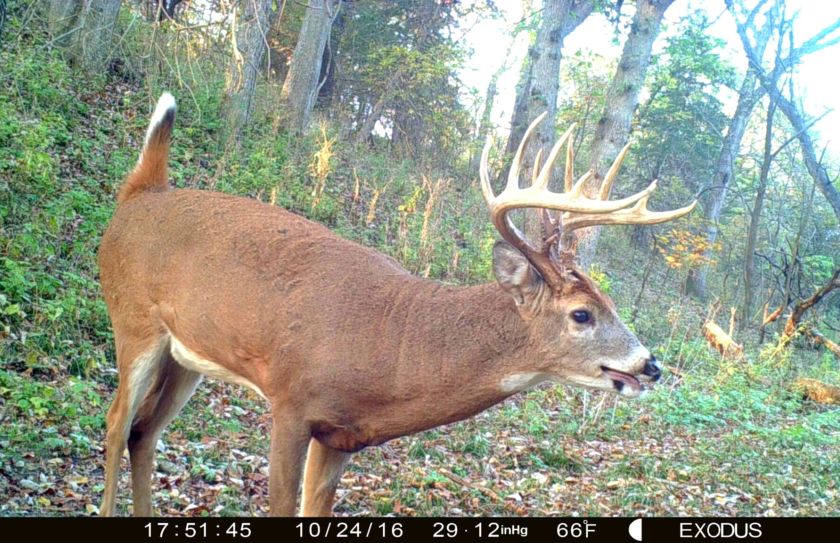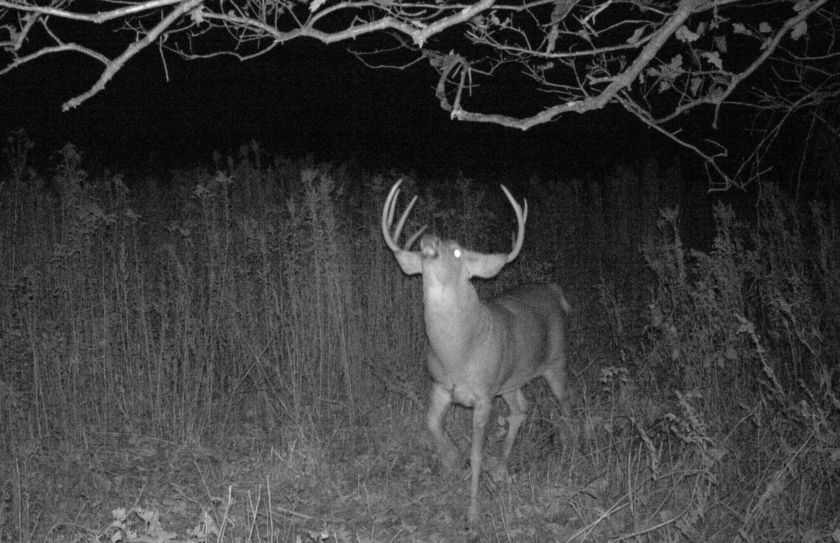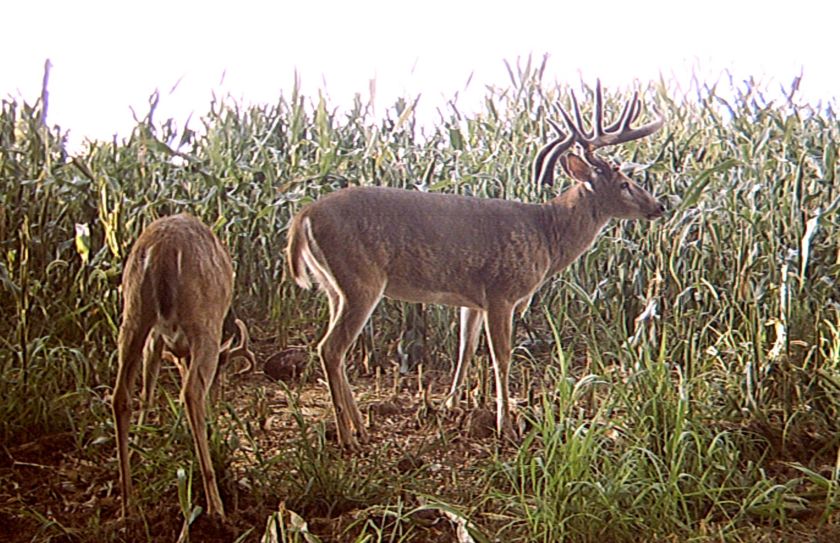It's time for Whitetail Game Camera Clues!
Let's get right to the point: 10s of thousands of game cameras are hitting the woods right now, but why? Capturing newborn fawns, various critters and giant velvet building monarchs is a great practice but the real trick is how you apply your discoveries to your hunting and habitat efforts. Here are 5 observations that you can use to raise bar when it comes to your success this fall!
1. Here Today, Gone Tomorrow:
Does need a similar type of habitat the entire year in the form of high stem count holding cover including grasses, weeds, briars, hardwood regen, shrubs and most any habitat type that allows for sufficient hiding opportunity. Some of the best fawning cover also has the highest stem counts per acre and this allows for not only the ability to hide fawns, but for optimum scent dispersion to limit predation rates and improve fawn recruitment. Does like it very thick almost the entire year and if you are getting limited pictures of mature bucks is this good, or bad?
Unlike doe family groups, a mature buck's cover needs shift drastically from the period covering late spring through early fall, to the hunting season and throughout the winter months. While in the course of my profession I have experienced the luxury of interviewing hundreds of clients concerning exactly if and when they are capturing their mature buck pictures on the lands they hunt. Throughout the years of scouring client pictures as well as my own, a common theme has emerged and been reinforced over and over again: Mature bucks often do not live in the summer, where they live in the fall.
Mature buck summer hangouts often include high, cool hardwood overstory and low stem counts which is exactly where they will not be hanging out during the months of the hunting season. Habitat that would literally have ripped their velvet softened antlers to considerable abnormalities in the summer, is actually where they choose to hide, hold and live during the fall. Often what appears to be the early October "lull" when mature bucks appear to experience a sudden decline in movements as well as sightings, is more likely that they just simply have shifted their habitat needs.
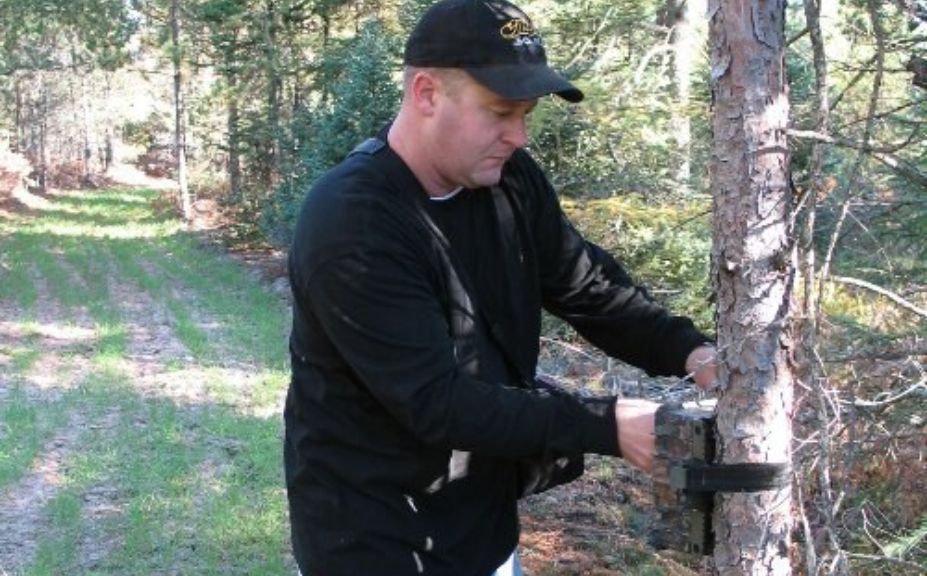
*Check out more game camera strategies in these articles:
1. Deer Cam Location Strategies 2. Spook Proof Deer Cam Guide
Game camera clues will allow you to determine not only the type of habitat that you are possibly lacking by following which deer are using your parcel at what time of the year, but they will also allow you to observe the seasonal shifts of mature bucks from summer to fall and back again.
2. The Numbers Game:
In every aspect of habitat management there are numerous balances that need to be identified and addressed. My visits across the country have revealed parcels that needed to experience a building process with a focus on safely increasing the deer population, to parcels with most likely 2-3 times more deer than could be supported. Your cameras will not only reveal the approximate current #s of deer on your parcel, but the seasonal and year-long changes in overall numbers as well. Here are a few clues to the game camera numbers game they you may discover on your land:
Your #1 time to influence the deer herd for the entire neighborhood is during the hunting season. When your parcel is at it's peak during November you have the ability to not only shoot deer, but to more importantly to attract, hold and choose not shoot young bucks in an effort to potentially promote them to the next age class. If your numbers are too low this is a great time to attract, hold and grow a herd and if your numbers are too high, an increasing hunting season population offers an outstanding opportunity to harvest antlerless deer when needed.
Declining deer numbers can be a result of low hunting season food volumes or diversity of food, habitats lacking in overall stem count per acre, hunting pressure or "all of the above". By identifying seasonal changes in deer numbers through the eyes of your game cams you can begin to assemble the puzzle of balance needed for your particular parcel.
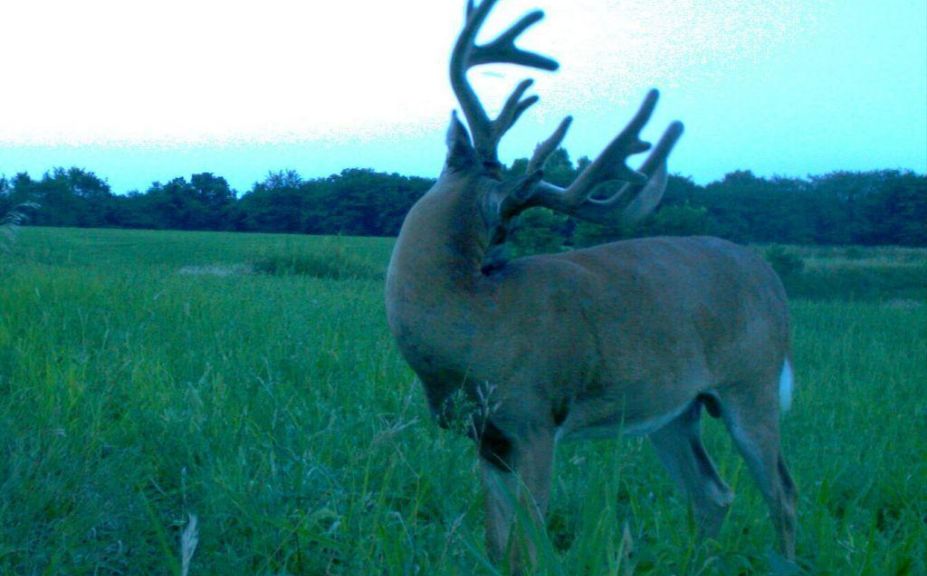
3. Breaks In Consistency:
We have a remote area we refer to as the "2 Acre Field" on our land. The location is adjacent to high quality and remote bedding opportunity and for most years holds a mature buck, or at least a mature buck in the making in the form of a 2-3 year old that begins to establish a more permanent residence. Not only is the use by bucks fairly consistent in this area, but so is the the use by the same doe family groups over and over again to the point that if we notice a change in the frequency and time of the pictures, an uncommon occurance has happened.
In 2010 we noticed a substantial drop in overall pictures for over a week during the time of late November. The lack of pictures was drastic and consistent for several day and we knew that deer had relocated for some reason. The answer was soon evident as we discovered an empty juice bottle at the base of one of the 2 treestands next to the 2 acre field. Tresspasser! There are never any absolutes when you are dealing with the variables of deer behavior, but it was easy to make a strong case that a tresspasser took to one of our stands, spooked deer by using the wrong stand for a particular wind and the deer just didn't return for several days. In 2012 we noticed the same drop in deer pictures in October. We were really puzzled until we caught pictures of a bear as he passed by and eventually brushed against our camera over multiple days. Cameras over waterholes have also revealed to us just how long it takes for deer to re-adjust their daily patterns after a lapse in water forced them to change course. During a drought we have watched pictures decrease from 50 day to 5, and then take an additional week or more to build back up to the same frequency after being re-filled with water.
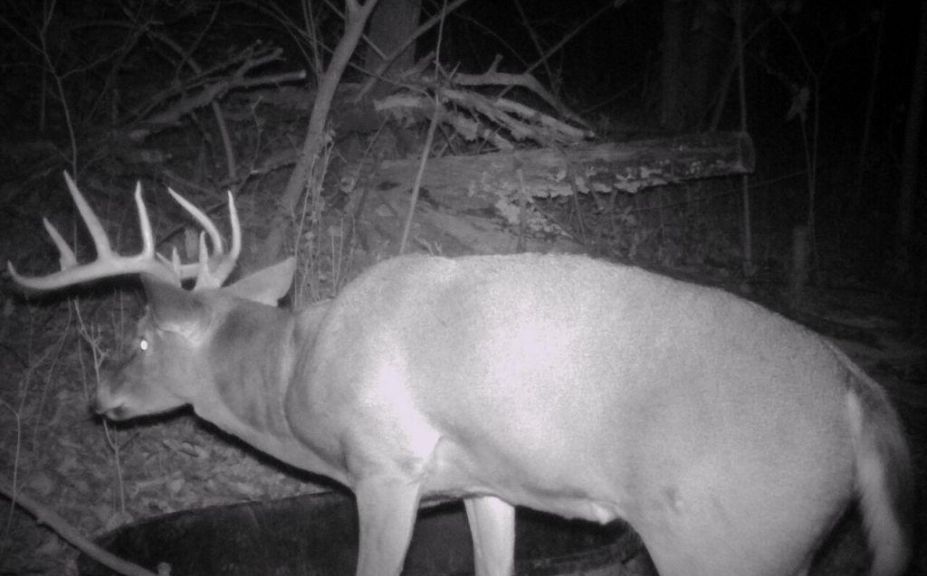
The consistency of deer use established within various areas of your land will give you many clues other than just bears, water and tresspassers. Shifts in food source use is another opportunity to study the local deer behavior no different than guaging the impact of your own hunting season movements as well as your neighbor's. Regardless of the reason for the break in consistency though, game camera clues give you an oustanding opportunity to learn volumes of information when various patterns of consistent deer use are broken on you property.
4. Direction Of Bedding:
Which bedding areas are used by which bucks on your acreage? Game cameras can tell you! A collection of pictures should be able to give you a direction of travel used by the individual bucks that live in and around your parcel which at the same time gives you clues into where and why those bucks choose to bed within a particular location. Are there areas that mature bucks always seem to hold during the daytime and other areas they seem to avoid? This is an outstanding opportunity to ask, "why?" You will find that you can learn just as much from areas that bucks seem to prefer as from areas they seem to not because consistencies will be revealed. This is no different when on public land, or private! When on public land you may have to experience miles of boot-time to find similar areas which may hold a giant or two, while on private land if you don't have those conditions within multiple areas on your own land-you can work hard to create it!
When hunting season is in full swing, discovering a direction of travel can point to a couple of very important aspects of hunting: Where to hang a stand, and where to access your property to avoid spooking deer. Knowing where a particular buck is traveling from can give you some great clues into how to develop an ambush to ultimately kill a buck in particular location, but the final piece of the puzzle a game camera can give you is when to kill him by learning how to establish his core area.
5. Core Areas for Monsters:
There are 2 patterns that you typically see with mature bucks including bucks that relate to a core area in and around your land, and bucks that prefer to define their core area on someone elses land.
*Core area (local) bucks will give you pictures frequent and close to shooting hours. There is no better time to kill a local buck than the present! I urge you not to wait until the "sweet-spot" of the rut to go in for the kill on these bucks because you may find that by that time they have temporarily relocated and exposed themselves to your neighbor's hunting efforts. Bucks are not as nocturnal as commonly believed, but instead if they do not appear until several hours after dark, they often do not have a core area within a 1/2 mile or more of your parcel borders. However, when a local buck is on your parcel he is killable in early bow season and all the way into the early rut.
Picture a local buck living within your parcel borders during the daytime hours. He is the king of the pre-rut, tearing up the woods, leaving lots of sign and chasing does as soon as the temperatures are cold during traditional pre-rut periods. Around here in SW WI that is anytime around the 20th of October and it also explains why on 1 parcel the pre-rut is in full swing...while on another the pre-rut is incredibly slow. The difference? The parcel with the extreme pre-rut activity has a local buck on it and the parcel that does not will be waiting for a non-local buck to travel to him from another parcel. A local buck finds a receptive doe fairly quickly during the pre-rut within his core area, and after a few days he most likely finds another somewhat easily. But, by the time he is starting to look for a 3rd doe the pickings may become mighty slim and a week to 10 days have passed. With the mid-rut now in full swing he really starts to explore his home range while wandering sometimes great and far. It is also at this time that if you waited, you may have already missed opportunities at a local buck as he travels to neighboring properties with the taste of love still on his mind. Your neighbor now may have a chance at a "non-local" buck traveling from your parcel.
*Non-Core area bucks (non-local) are often very visible during the growing season, either on your own land through the lens of a game camera, or on your neighbor's fields as they lazily dine all summer long. But whether you see them during the summer months or not, they eventually give way to infrequent pictures often taken during the middle of the night. Non-local bucks I have gotten to know and kill have established core areas a 1/2 mile to 3/4s of a mile away or more with some bucks coming from core areas up to 2 miles away! A frequent pattern emerges of only handful of pictures (if any) spread out over late September and October and rarely if ever even close to shooting hours. The buck isn't sitting back on your land and waiting to move until he middle of the night but instead he doesn't get his picture taken until the middle of the night because of the distance he had to travel to get to your land, which also explains the infrequency of pictures.
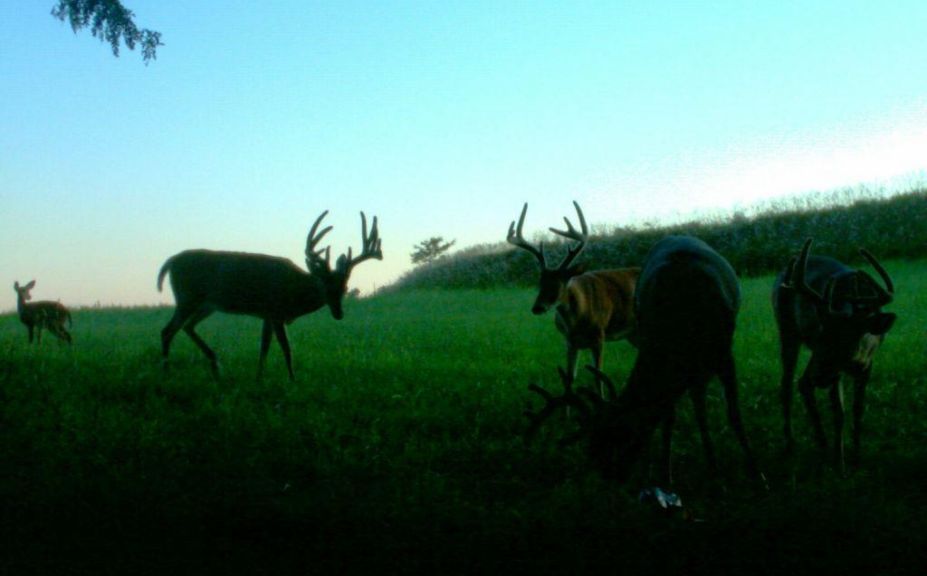
*Learn how game camera clues can help you determine where and when to harvest you next monster by reading,"Core Mature Buck Hunting Strategies".
By using game camera clues you can not only define the local bucks that have established a core area on your land, but also the non-local bucks that will most likely not show up until the mid-rut or later. Patience is very critical when going after a non-local buck. During 2012 we lost 11 bucks we had pictures of between the ages of 3 and 8 that were killed by hunters in and around our land. To say that the pickings were slim in 2013 was an understatement so I had to rely on hunting 2 particular non-local bucks by being patient and preserving stand locations I thought I could possibly kill them out of during the rut and later. If I used these stand locations too early the bucks had a very low chance they would ever show themselves and I could potentially spoil the stand set-ups by spooking doe family groups within the area. My patience was rewarded with the harvest of a WI archery harvest of a non-local buck on November 6th as he traveled from his core area a 1/2 mile North, and again around 10:30 during WI's rifle opener as a non-local giant traveled from his core area over a mile from the East to seek refuge on our lightly pressured property. Both bucks were shot using the stand for the first time for the year and we had 3 pictures of the rifle buck scattered in mid-October to mid-November, and the only pictures we captured of the bow buck were from my neighbor's 2 parcels away, and the prior year on our own land. In both cases the cameras were not only critical for revealing where to hunt, but just as importantly when to hunt.
Conclusion
Right now is the time to fasten your game cameras to the trees and begin to unravel the clues to the upcoming hunting season. At the same time cameras can reveal to you critical information about the balance of habitat, food and populations numbers on the land you hunt. There are some that may feel that the risks of spooking deer are not worth the hassle of the game cameras, but I have found the rewards ultimate hunting strategy as well as the opportunity to discover hidden deer behaviors far outweigh any assumed risks. At the same time by placing cameras at the edge of "people areas", for example near stand locations, open food plots or even exposed water sources and mineral stations you can both minimize risk while at the same time capturing a pretty inclusive sampling of the bucks within the area, let alone your own property.
Game cameras offer you many clues that can help you discover favorable habitat conditions for both bucks and does, improve your hunting opportunities, as well as to begin to assist you to unravel the mysteries of deer behavior. Game camera clues can offer you an advantage that you can't afford to miss, and I encourage you to explore the depth of information that they can deliver to you.
